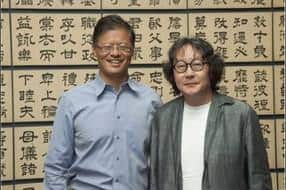“Out of Character: Decoding Chinese Calligraphy,” is the first major exhibition of Chinese calligraphy in the U.S. since 1999. After its presentation at the Asian Art Museum, the exhibition is scheduled to tour to the Metropolitan Museum of Art, New York, in 2014.
In his book of the same name, Michael Sullivan named Chinese painting, poetry and calligraphy as the “three perfections” of Chinese culture.
In the current show at the Asian, calligraphy is presented in such a way as to illuminate those three perfections. The careful viewer will leave the show with a deeper understanding of the historical and spiritual dimensions of this ancient, but still living, form of writing.
Up until now there has been little to help the Western public to understand Chinese calligraphy, beyond appreciating it as an abstract art form. Non-Chinese viewers may have a sense of what Chinese calligraphy feels and looks like, but not a clear idea of where it comes from or the layers of meaning behind each symbol.

Therefore, “Out of Character: Decoding Chinese Calligraphy,” an exhibition of forty masterpieces chosen from the collection of Bay Area entrepreneur Jerry Yang, is a welcome look at this magnificent art form, still practiced by millions of people.
Forty works were selected by the curators of the show, Michael Knight and Joseph Chang. Of the 40, about 15 are considered “Featured Works,” which are important, significant, or monumental works by the artist. These 15 works will be shown in their entirety, in innovative ways so that people can view them in a contemporary and accessible way.
“Through the centuries, a complex set of rules and conventions evolved in this art form, governing scripts, styles, formats, content, and context, and impacting every aspect of the Chinese calligrapher’s practice,” said Jay Xu, director of the Asian Art Museum.
“The unique mix presented in “Out of Character” — classic calligraphies complemented by modern and new works — offers a framework for understanding that within these constraints, creativity and self-expression remained the goals of the calligrapher.”
Divided into three different sections, the show leads the viewer through origins, methods and materials to a modern interpretation via an animated piece by living master Xy Bing. There are a number of paintings by Western painters whose works have been influenced by Asian calligraphy – Franz Kline, Mark Tobey and Bice Marsden.
“The sutra on the Lotus of the Sublime Dharma,” by 13th century calligrapher Zhan Mengfu is one of the oldest examples in the show. With over 10,000 characters, it is a testament to the absolute control, concentration and endurance of the calligrapher.
Long cases allow scrolls to be entirely unrolled. One room features an impressive curved wall on which all 85 pages of a large album can be viewed at once. There’s a hanging scroll that is taller than the gallery and crawls onto the ceiling. The calligraphy changes from dynasty to dynasty and era to era and calligrapher to calligrapher, just as Western calligraphy changed from Gothic to Humanistic cursive to Spenserian over the course of several hundred years.
As curator Michael Knight pointed out, a good calligrapher was judged to be a paragon of scholarship, sensibility and taste. To be a poor calligrapher reflected a poor character. To become a calligrapher meant that the practitioner underwent a rigorous training, which enabled him (or sometimes her) to wield the brush with sensitivity and control. The calligrapher Ts’ai Yuan, writing in the later Han dynasty, advises the calligrapher to wait for the inevitable moment by releasing his thoughts before starting to write.
Jerry Yang said that as a child, he had no patience for the rituals of calligraphy – grinding ink, the endless practice, the never-ending discipline. Technology interested him, not what he saw as the arcane and useless study of the past. But as an adult, he rediscovered Chinese calligraphy as a “journey of discovery, inspiration, and fulfillment.”
For the CEO of Yahoo, it must have been a revelation to realize that art made from the simplest low tech materials was capable of expressing the highest thoughts of the human mind and spirit.
Over a thousand years ago, Zhao Mengfu (the man who penned the sutra on the lotus,) wrote:
“I’m gap-toothed and bald-headed at sixty-three.
And everything in my life should make me feel ashamed.
Only my passion for the products of brush and ink remains –
I’ll leave them behind to give the world something to joke about.”
Nobody will be joking when they view the show. The collection is stunning, magnificent and insightful, a revelation to all who view it.
“Out of Character: Decoding Chinese Calligraphy” is on view at the museum through January 13, 2013.
Where: Asian Art Museum, 200 Larkin Street, S.F.
When: 10 a.m. to 5 p.m. Tuesdays-Sundays; closes Jan. 13
Tickets: $8 to $12
Contact: (415) 581-3500
This article originally appeared in Examiner.com
